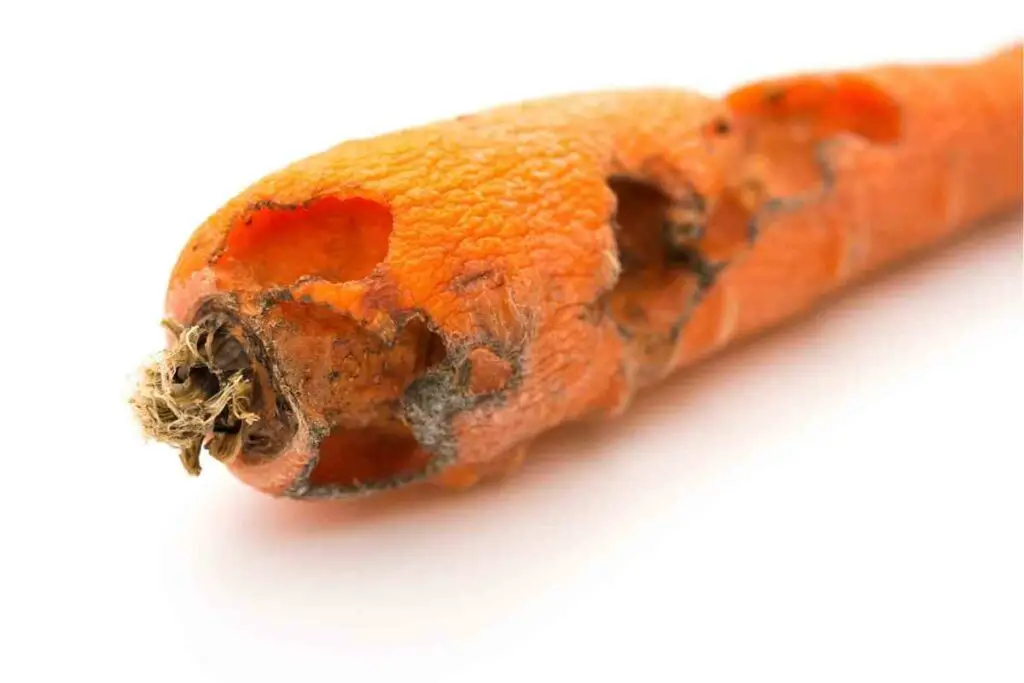If you have carrot flies in your garden, there are very few organic treatment options. You can cover the non-affected crops with ground covers to protect them against fly advancement.
Additionally, use crop rows, crop rotation, and allium plants to prevent the flies from coming back next year.
Keep reading to learn more about getting rid of carrot flies and preventing them from destroying your crop.
In this article, we describe the carrot fly lifecycle, signs of carrot flies, how to get rid of the flies, and tips for preventing them from ruining future crops. Scroll down for more.

Table of Contents
What Are Carrot Flies?
Carrot flies are small insects that feed on carrots and similar plants. Some other plants that carrot flies love to target include celery, dill, parsley, and parsnip.
The adult fly will lay their eggs on top of the soil. Whenever the eggs hatch, the worms will burrow into the carrot root. during the summer, the larvae will do a lot of damage to the plant and remain dormant inside any leftover carrots and plants.
It is during the larvae stage that the carrot flies do so much damage.
To make matters worse, carrot flies reproduce multiple times throughout the year, which means there are lots of hungry larvae that appear throughout the entire gardening season.
How Do I Know My Garden Has Carrot Flies?
In order to get rid of carrot flies, you must first know what to look for. Unfortunately, it can be difficult to know that carrot flies are in the area until they have already damaged your crop. That is because most of the problems happen away from sight underground.
Whenever the plants are young and tender, it is likely that they will die if infected with carrot fly larvae.
In comparison, some plants will look completely fine from the top but have a lot of damage inside and a misshapen look once picked.
One of the first signs that there is a carrot fly infestation on your hands is that there is damage at the root’s crown. This damage develops whenever larvae migrate to the stalk and leaf part of the plant.
If you suspect that you have carrot flies, you should place sticky traps around the plant. If there is a fly infestation, there should be several flies stuck in the trap.
The only way to confirm that carrot flies are targeting a crop is to pull up a carrot and break it open. If there are little worms throughout the carrot’s root, you have confirmed that carrot flies have made your garden their home.
How Do You Get Rid Of Carrot Flies?
Unfortunately, there isn’t much you can do to get rid of carrot flies after they have already dug into your produce.
That is because it is next to impossible to determine which areas are affected and treat the flies without destroying the produce along the way.
Save Remaining Crops with Row Covers
If there are parts of your garden that are not affected, there are things you can do to protect what produce is salvageable. We recommend using row covers.
Row covers are the most effective way to prevent carrot flies from spreading to salvageable crops. The earlier you can cover the plants, the better.
As soon as you spot flies around your carrots, put covers down.
Once you can spot flies, they are in the adult phase and can start laying eggs around your plants. For even better results, simply put the covers over the plants before flies are spotted to ensure no larvae get to your carrots.
Prepare for Next Year
You will need to prepare your soil for next year once carrot flies have been spotted. After an infestation, turn over the soil occasionally. This makes it more likely that birds will eat up the larvae and pupae, resulting in fewer flies next year.

How Do I Prevent Carrot Flies From Coming Back?
Because it is next to impossible to get rid of carrot flies, prevention is the best treatment. By preventing carrot flies from laying their eggs in the first place, you won’t have to worry about the eggs destroying your entire crop of carrots.
Use Row Covers
As described above, row covers are the most effective organic prevention method for carrot flies.
Row covers are designed to prevent carrot flies from getting to your plants and laying their eggs. Without access to the plant, the flies won’t be able to eat your produce.
The problem with row covers is that they won’t help you at all if the flies are already present.
So, you will want to place row covers over your carrots as soon as they are planted. That way, your carrots are protected before flies are ready to lay eggs.
The best time to plant your carrots is as late as possible. If you delay planting the plants, it is more likely that the adult larvae won’t have anywhere to lay their eggs. When this happens, future generations of carrot flies are stopped in their tracks.
Rotate Your Crops
In addition to using row covers, make sure to rotate your crops.
Rotating your crops will help to fight carrot fly infestations from lasting year to year. Because carrot flies do not fly far, rotating your crops can do a lot of good for preventing them from coming back.
Plus, crop rotation is simply good for your soil and garden. By rotating your crops, the soil is not depleted of all of its key nutrients.
Try Companion Planting
Whereas certain plants are more susceptible to carrot flies, others are more likely to deter the flies.
Besides your carrots, try to plant produce that deters flies, such as plants within the allium family. Chives, onions, and leeks often deter flies because of their strong scent.
Whenever you rotate your carrots and affected crops, do not forget to rotate the allium plants too. That way, your carrots are protected in the new location as well as the old one.













